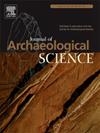Technology, inhabitants and ritual traditions revealed by scientific analyses of Eastern Zhou bronze artefacts from the Lu state, Qufu, China
IF 2.5
1区 地球科学
Q1 ANTHROPOLOGY
引用次数: 0
Abstract
Bronze ritual vessels played a crucial role in Chinese civilisation during the Bronze Age of China. However, bronze artefacts from the Lu state, one of the vassal states which fully implemented the Rites of Zhou, have rarely been scientifically analysed. This study presents the metallographic and elemental results as well as lead isotope ratios on 67 bronze artefacts excavated from three burial complexes in Qufu, the capital of the Lu state (8th–3rd century BCE). The results suggest that craftsmen understood the effect of alloy compositions on the mechanical properties of the objects and skilfully produced forged, thin-walled vessels with low lead content for ritual purposes. Furthermore, by integrating lead isotope data with archaeological contexts, it reveals the similarities and differences in lead isotope ratios between bronze artefacts belonging to different genders, social strata and vassal states, as well as diachronic changes in metal circulation networks. This offers a new perspective for understanding the social and cultural changes during the Eastern Zhou period.
中国曲阜鲁国东周青铜器的科学分析揭示了技术、居民和仪式传统
在中国青铜器时代,青铜礼器在中国文明中起着至关重要的作用。然而,作为全面实施周礼的诸侯国之一,鲁国的青铜器却很少得到科学的分析。本文介绍了从鲁国首都曲阜(公元前8 - 3世纪)三个墓葬群中出土的67件青铜器的金相、元素分析结果和铅同位素比值。结果表明,工匠们了解合金成分对物体机械性能的影响,并熟练地制作了锻造的、低铅含量的薄壁容器,用于仪式目的。此外,通过将铅同位素数据与考古背景相结合,揭示了不同性别、不同社会阶层和不同诸侯国青铜器铅同位素比值的异同,以及金属循环网络的历时变化。这为认识东周时期的社会文化变迁提供了一个新的视角。
本文章由计算机程序翻译,如有差异,请以英文原文为准。
求助全文
约1分钟内获得全文
求助全文
来源期刊

Journal of Archaeological Science
地学-地球科学综合
CiteScore
6.10
自引率
7.10%
发文量
112
审稿时长
49 days
期刊介绍:
The Journal of Archaeological Science is aimed at archaeologists and scientists with particular interests in advancing the development and application of scientific techniques and methodologies to all areas of archaeology. This established monthly journal publishes focus articles, original research papers and major review articles, of wide archaeological significance. The journal provides an international forum for archaeologists and scientists from widely different scientific backgrounds who share a common interest in developing and applying scientific methods to inform major debates through improving the quality and reliability of scientific information derived from archaeological research.
 求助内容:
求助内容: 应助结果提醒方式:
应助结果提醒方式:


